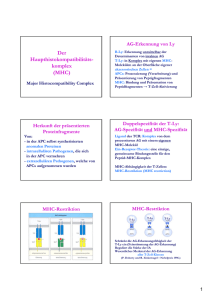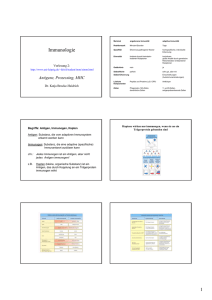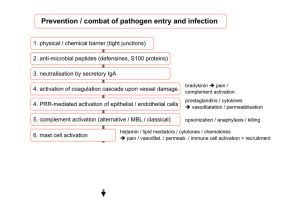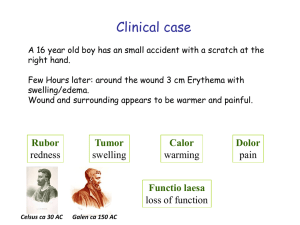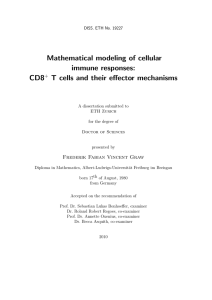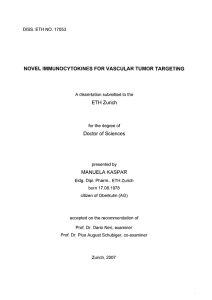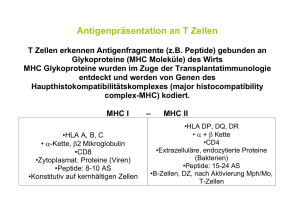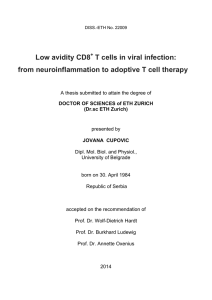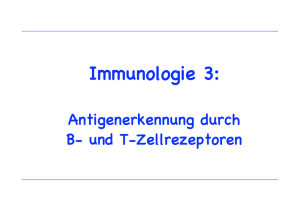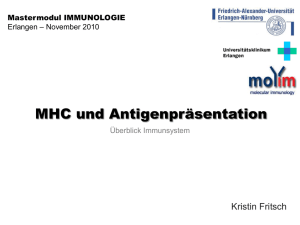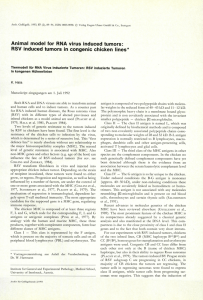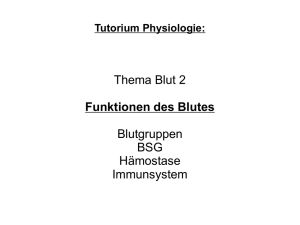VL 5 - Innate phagocytosis and antigen presentation
Werbung
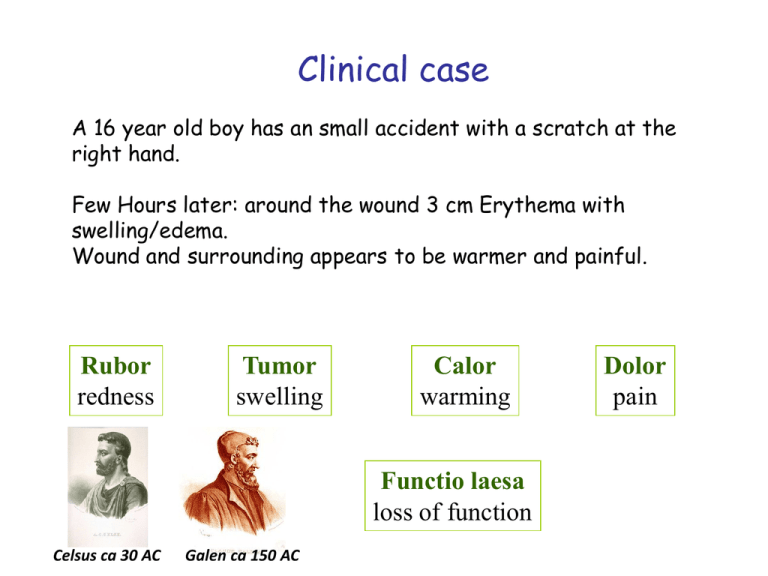
Clinical case A 16 year old boy has an small accident with a scratch at the right hand. Few Hours later: around the wound 3 cm Erythema with swelling/edema. Wound and surrounding appears to be warmer and painful. Rubor redness Tumor swelling Calor warming Functio laesa loss of function Celsus ca 30 AC Galen ca 150 AC Dolor pain What can trigger an inflammation? pathogen infection Injury, mechanical stress, Trauma Cell death – DANGER! Activation of the immune system Elimination of pathogen Removal of dead cells What can trigger an inflammation? pathogen Typical Biochemical structures= patterns Injury, mechanical stress, Trauma PAMPs= DAMPs=Alarmine Pathogen Associated molecular patterns Damage associated molecular patterns Pattern recognition receptors = PRRs (soluble and cell-associated) Activation of the immune system Elimination of pathogen Removal of dead cells Mustererkennungrezeptoren (PRRs) • membrangebundene PRRs scavenger Rezeptoren Toll-like Rezeptoren C-Typ-Lektin-Rezeptoren Erkennung nach Opsonisierung: mit Antikörpern: Fc-Rezeptoren mit C3b: Komplement-Rezeptoren CR3 • cytosolische PRRs NOD-like Rezeptoren (NOD1, NOD2) RIG-I-likeRNA-Helikase • sezernierte Proteine Collektine: (gehören auch zu C-Typ-Lektinen) Mannose-bindendes Lectin (MBL) und surfactant protein A, D (SP-A, SP-D) Ficoline Pentraxine: Serum Amyloid, C-reaktives Protein, • endozytierende Rezeptoren • signalgebende Rezeptoren: adaptive Immunantwort (Expression von Cytokinen , kostimulatorischen Proteinen • Komplement-Aktivierung Inhibition of virus replication by IFNa/b IFNa/b 2-5OA RNAseL Degradation of dsRNA PKR eIF2-p PKR = RNA-dependent protein kinase 2-5OA = 2´-5´ oligoadenylate synthetase translation Alarmins = DAMPs (damage/danger associated molecular patterns) Necrotic dying cells release danger signals ECM infection MSU Cell death Inflammasome activation ATP Trauma Injury burn DC HMGB1 HSPs inflammation Plasma enzymes HMGB = high mobility group B HSPs = heat shock proteins MSU = monosodium urate; uric acid crystals ECM = extra cellular matrix ECM Degradation (e.g. Hyalunoric acid) TLR Stimulation (also other receptors) cytokines Partikel, die zum lysosomalen Schaden (und damit mitochondrialen Stress) führen, aktivieren das Inflammasom und damit Entzündung Beispiele: Harnsäurekristalle (Gicht), Asbest, Nanopartikel (Kosmetika), Aluminiumsalze (Adjuvanz) fMet mtDNA DAMPs get released by necrotic but not apoptotic cells DAMPs can get inactivated during Apoptosis Summary PRR signaling pathogen 3) Sekretion of pro-inflammatory mediators by immune cells (Makrophages, Dendritic cells) bioactive lipids (Thromboxanes, Prostaglandines, leukotriens) Vasodilation Higher blood circulation rubor=redness cytokines Activation of local endothelial cells chemokines attract „gorging“ phagocytic cells tumor=Swelling Synthesis of bioactive Lipids Pharmacological Targets: Phospholipase A2 Cyclooxygenase (COX) Ibuprofen Gewebe (Haut) Haut (Epithel) Komplement aktivierung MΦ Mast zelle Histamin Blutgefäß DCs PGs Öffnung Vaso Tight dilatation junctions Chemokine Zytokine (z.B. TNFa, IL-1) (z.B. IL-8 = CXCL8) Influx C +AK Induktion Influx Adhäsions Granulozyten moleküle PAMPs = pathogen associated molecular patterns DAMPS = danger/damage associated molecular patterns PRRs = pattern recognition receptors Gewebe (Haut) Haut (Epithel) Komplement aktivierung MΦ Mast zelle Histamin Blutgefäß DCs PGs Öffnung Vaso Tight dilatation junctions Chemokine Zytokine (z.B. TNFa, IL-1) (z.B. IL-8 = CXCL8) Influx C +AK Induktion Influx Adhäsions Granulozyten moleküle PAMPs = pathogen associated molecular patterns DAMPS = danger/damage associated molecular patterns PRRs = pattern recognition receptors neutro neutro LFA-1 ICAM-1 TNFa, IL-1 CXCL8= IL-8 Macro PAMPs Clinical case development • Afternoon: ague (shivering fever) 38,5 oC. Local inflammation signs enhanced. • Additonally signs of Lymphadenitis and swelling of lymphnodes. • Medic prescribes Antibiotics (Ampicillin) and lokal cooling Kühlung. Start of acute phase response „Warning“ remote response cytokines Tumor Necrosis Factor alpha (TNF-a) Interleukin-1 (IL-1) Pyrogene cytokines Interleukin-6 (IL-6) Granulocytes/Monocytes Colony Stimulating factor GM-CSF Hypothalamus Temperature Set point changes Liver Synthesis of Acute-Phase-Proteins Bone marrow New synthesis of Phagocytic cells Fever u.a. Opsonisation „Linksverschiebung“ Akut Phase Proteine Opsonisierung: Markierung von Erregern durch Bindung an Erregerstrukturen für die erleichterte Phagozytose Beispiele: Collectins: C reaktives Protein (CRP) mannose binding protein (MBP) serum amyloid protein (SAP) surfactant proteins (SP-A SP-D) Komplement C3 (C3b) Energy for the immune system Adipocyted Lipolyse LipoproteinlipaseActivity Lipid metabolism Muscle cells IL-1 and TNF-alpha Protein metabolism Appetite cachexia and Wasting Makrophage functions 1) Secretion of pro-inflammatory mediators a) cytokine b) chemokines c) bioactive lipids 2. Phase: attraction/accumulation of more/other immune cells 2) Phagocytosis 3) Killing of phagocytosed pathogen Phagozytosis receptors for opsonized pathogenes ? CRP-Rezeptor (CD32??) ? MBP-Rezeptor (CD14??) CRP MBP Fibronektin Komplement (C3b) Integrine „Pathogene Oberfläche“ C3b CR1 (CD35) Antikörper Fc-Rezeptoren (CD16; CD32; CD64) Opsonisierungsprinzip Makrophagen Phagozytosis receptors for non-opsonized pathogenes Scavenger-Rezeptoren: SR-A I+II MARCO Lektin-type-Rezeptoren: Mannose Rezeptor b-Glukan-Rezeptor (Dectin-1) LPS-Rezeptor CD14 Phagozytose-Rezeptoren für opsonisierte Pathogene ? CRP-Rezeptor (CD32??) ? MBP-Rezeptor (CD14??) CRP MBP Fibronektin Komplement (C3b) Integrine „Pathogene Oberfläche“ C3b CR1 (CD35) Antikörper Fc-Rezeptoren (CD16; CD32; CD64) Opsonisierungsprinzip Makrophagen Phagozytose 1) Aufnahme des Erregers - Pseudopoiden - Aufnahme in die Zelle - Ablösung von Zellmembran 2) Verschmelzung mit Lysosom - Phagolysosom - saurer pH 3) Abtöten des Erregers - oxidative burst (O2-Radikale; NO) 4) Abbau der Erregerbestandteil - Enzyme (Hydrolasen, Proteasen, etc...) Principles of KILLING ROS-formation ROS = reactive oxygen species „respiratory burst“ Stickstoffoxid-abhängiges Abtöten Trotz „unfreundlicher“ Bedingungen Überleben von intrazellulären Bakterien Beispiele: Mycobakterien tuberculosis leprae Phagozytose nicht möglich-Was nun? Parasiten z.B. Würmer „Frustrierte“ Phagozytose Degranulation C3a C5a Fce IgE Mastzellen Eosinophile Basophile Phagozytose nicht möglich-Was nun? Hermetisch „Abriegeln“ Granulom What happens if you have a mutation in the NAPDH-Oxidase Chronic granulomatosis Gewebe (Haut) Haut (Epithel) Komplement aktivierung MΦ Mast zelle Histamin Blutgefäß DCs PGs Öffnung Vaso Tight dilatation junctions Chemokine Zytokine (z.B. TNFa, IL-1) (z.B. IL-8 = CXCL8) Influx C +AK Induktion Influx Adhäsions Granulozyten moleküle PAMPs = pathogen associated molecular patterns DAMPS = danger/damage associated molecular patterns PRRs = pattern recognition receptors Von der angeborenen zur erworbenen Immunität: Transport von Erregerbestandteilen zum Lymphknoten TLR Von der angeborenen zur erworbenen Immunität: Lymphknoten – Treffpunkt der Immunzellen Activation of inflammation by „Danger“ is required to initiate an immune response apoptotic cell death necrotic cell death NO danger Damage (DAMPS) DC Pathogen (PAMPS) DC Ag presen tation T soluble Mediators (e.g. cytokines) Ag presen tation costimulation T Lymphe und Lymphbahnen • Lymphe: wasserklare Flüssigkeit; nur viszeral durch Chylomikronen milchig getrübt; bis 2 L/d werden in die Blutbahn eingespeist • Gefäße und Leitungen, welche Flüssigkeit der Gewebe aufnehmen und zurück zur Blutbahn bringen (überwiegend linke Schlüsselbeinvene) Immunologie-Vorlesung MHC und Antigenpräsentation • Haupthistokompatibilitätskomplex (MHC, major histocompatibility complex) • Antigen-Prozessierung • Professionelle Antigen-präsentierende Zellen: Dendritische Zellen, B-Zellen und Makrophagen soweit nicht anders angegeben, Abbildungen aus Janeway´s Immunobiology, Garland Science, 8.ed. / 2008 Antigen presentation via Major histocompatibility Antigens responsible for Transplant rejection Major histocompatibility complex = MHC (all spezies) In Humans they are named: Human Leukocyte Antigen = HLA Erworbene Immunität: Aktivierung von CD4+ T-Helfer-Zellen Extrazelluläre Erreger Antigen präsentierende Zelle • Extrazelluläre Erreger werden in endozytotischen Vesikeln prozessiert und über MHC Klasse II Moleküle CD4+ T-Helfer-Zellen präsentiert. • MHC Klasse II Moleküle werden nur von Antigen präsentierenden Zellen exprimiert (Dendritische Zellen, Makrophagen, B-Zellen) MHCII-presentation Erworbene Immunität: Aktivierung von CD8+ zytotoxischen T-Zellen Infizierte Zelle viral protein Major Histocompatibility Complex • Intrazelluläre Erreger werden durch das Proteasom prozessiert und über MHC Klasse I Moleküle den CD8+ zytotoxischen T-Zellen präsentiert. • MHC Klasse I Moleküle werden von allen Körperzellen exprimiert MHCI-presentation Antigen-Präsentation von cytosolischen Antigenen über MHC-I • fehlgefaltete cytosolische (und virale) Proteine werden ubiquitiniert und im Proteasom gespalten • über einen ABC-Transporter (TAP) ins ER transportiert • dort an MHC-I-Moleküle gebunden und zur Zelloberfläche transportiert Viruses have evolved different evasion strategies for MHCI escape MHC class I MHC class II HLA-A, B und C = HLA-DR, DP und DQ Presentation of endogenes Antigens (host, Tumors, Viruses) Presentation exogenes Antigens (Bakterien, Pilze etc.) all nucleated cells Only on specialized Antigen-presenting cells (=APCs) (DCs, Makrophages; Monocytes, B-cells) Recognition by cytotoxic T-Lymphozyten (CD8+) Recognition by T-Helper Lymphozyten (CD4+) Professionelle antigenpräsentierende Zellen Dendritische Zelle FcR, CR, Mannose receptors, DEC-205 phagocytosis Viral Infection macropinocytosis endocytosis Endosomes/lysosomes cross presentation Cytosol MHC-I MHC-II starke Induktion der Expression von MHC-II und B7 durch verschiedene Rezeptoren (TLR, scavenger receptor, CR, MMR), geeignetes Wanderungsverhalten (treffen T-Zellen in den Lymphknoten Makrophage phagocytosis FcR, CR, Mannose receptors Endosomes/lysosomes MHC-II B-Lymphozyt kostimulatorisches Molekül B7.1 wird durch LPS induziert BCR B cells only internalize antigens that bind to BCR. MHC-II stark exprimiert Induktion der Expression von MHC-II und B7 durch verschiedene Rezeptoren (TLR, scavenger receptor, CR, MMR) MHC-II How can DCs prime naive CD8+ T cells for viral antigens ? MHC class I MHC class II HLA-A, B und C = HLA-DR, DP und DQ Presentation of endogenes Antigens (host, Tumors, Viruses) Presentation exogenes Antigens (Bakterien, Pilze etc.) all nucleated cells Only on specialized Antigen-presenting cells (=APCs) (DCs, Makrophages; Monocytes, B-cells) Recognition by cytotoxic T-Lymphozyten (CD8+) Recognition by T-Helper Lymphozyten (CD4+) Crosspresentation (viral epitopes for naive CD8+ T cells) MHC-Molecules have a similar structure Peptid-binding MHC-I Region (Polymorph) Immunoglobulinlike region (non polymorph) MHC-II b2 Mikroglobulin Transmembranär MHC-Molecules have a similar Structure MHC class I HLA-Klasse I - Präsentiert Peptide, die von der Zelle gebildet werden - Peptide von 8-9 Aminosäuren - Auf allen Körperzellen vorhanden - Rezeptor für CD8-Positive Zytotoxische „Killer“- T-Zellen Ausnahme: Dendritische Zellen können auch Peptide von aussen aufgenommenen Proteinen auf Klasse I präsentieren (CROSS-PRIMING) - „Priming von zytotoxischen CD8 T-Zellen in der primären Immunantwort - Mechanismus noch unklar MHC-Moleküle haben eine ähnliche Struktur MHC class II HLA-Klasse II - Präsentiert Peptide die von der Zelle aufgenommen werden (Phagozytose oder Pinozytose) - Peptide von 13 und mehr Aminosäuren - Auf Antigenpräsentierenden Zellen vorhanden - Rezeptor für CD4-Positive Helfer- T-Zellen MHC-Molecules are polygenic There are 3 major gene loci for each class of MHC-Molecules Ch. 6 Ch. 17 MHC-Molecules are polymorphic There are several alleles for each Gene insight the population. MHC-Molecules are polymorphic There are several alleles for each Gene insight the population. Expression of MHC allelel is codominant How many different MHC-I molecules are expressed on each cell? How diverse are your individual MHC molecules? How many different MHC-I molecules are expressed on each cell? How can we nevertheless achieve to present a wide range of different epitopes?? Only Anchor-amino acids must fit Example of HLA-I Allel specific Peptides Are we able to present each theoretical possible epitope? Bindung der Peptide an MHC-I und II MHC-I MHC-II Peptid (8-10 AS) bindet mit seinen Enden passgenau in der Furche Peptid ( 13 AS) kann auf beiden Seiten über die Furche ragen Bindung über C/N-Terminus, Ankerreste (z.B. C-terminale AS hydrophob) Ankerreste an verschiedenen Stellen innerhalb des Peptids Peptide aus Abbau von fremden (und eigenen) Proteinen im Proteasom (z. B. von Viren infizierten Zellen Peptide von über Endozytose aufgenommenen und prozessierten Proteinen Beispiel (abhängig vom jeweiligem MHC-Molekül) If we have individually only a restricted set of MHC molecules Why do we need polymorphic MHC alleles ? (bad for transplantation...) Why do we need polymorphic MHC alleles ? (bad for transplantation...) Not all theoretical epitopes can be generated by proteasome (switch by IFNg induced immunoproteasome, other proteases can generate epitopes) Not all generated epitopes can be presented by a particular MHC allele (anchor positions must fit!) Selection of variability in population (by smell) At least some survive the plague.... Lck CD4 und CD8 als Korezeptoren CD4 • erkennt MHC-II • eine Polypeptidkette mit 4 Ig-ähnlichen Domänen • D1 bindet an a2/b2-Domäne von MHC-II • wird von T-Helfer-Zellen exprimiert Lck CD8 • erkennt MHC-I • Dimer aus a und b-Kette mit je 1 Ig-ähnlichen Domäne, über eine hochglykosylierte (und deshalb gestreckten) Polypeptidkettenabschnitt mit dem Membransegment verbunden • bindet an a3/a2-Domäne von MHC-I • wird von zytotoxischen T-Zellen exprimiert CD8+ / die lymphocyte-specific protein tyrosine kinase (lck) ist eine mit CD4/CD8 assoziierte Tyrosinkinase TH-Zellen: Bindung von MHC-II an TCR/CD4 TC-Zellen: Bindung von MHC-I an TCR/CD8 Immature DC Principal function Expression of FcR, Mannose-R Expression of Co-stimulatory Molecules (CD80/CD86) MHCII Antigen capture Mature DC Antigen presentation ++ - - or low ++ half life 10h 100h number of surface molecules 106 7x106 mDCs CD8- pDCs CD11c-low CD11b-negative B220-high mDCs CD8+ Surface markers CD11c-high CD11b-high TLR expression TLR 4, 5, 8 TLR 7, 9 TLR 3 Major cytokines TNF, IL-6 IFN-a, b IL-12 Ability to cross present Major function +/- Induction of T cell response against most antigens +/- Induction of T cell response against viruses CD11c-low/high CD11b-negative CD8a+ ++ activation of CD8+ T cell response by cross priming Figure 5-17 (Alternative) Antigenpresentation of (Glyco)lipids via CD1 CD1d CD1c CD1a, b, c Glycolipids lipids lipids NKT cells d-T cells IL-4, IFN- IFN- CD1-restricted ab-T cells IFN-g
